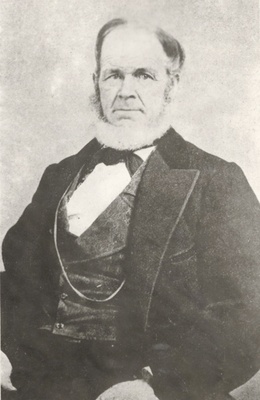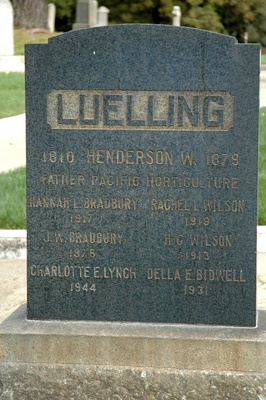 Henderson Luelling
Henderson Luelling
photo from Peralta Hacienda collectionsHenderson William Luelling (April 23, 1809 – December 28, 1878) was an early Oakland settler and nurseryman who introduced varietal fruits to Oregon and later to California, and gave the Fruitvale district its name.
Note that in many records his family name is spelled Lewelling but his grave marker says Luelling. At some point Henderson changed the spelling of the name. Similarly, some records list his birth year as 1809 or 1810, and his death year as 1878 or 1879.
Family
Of Welsh descent, Henderson’s grandfather was a Quaker, well-versed in the Bible, who named his sons Shadrach, Meshach, and Abednego (from the book of Daniel). Henderson’s father, Meshach Lewelling, was a physician and nurseryman in Randolph County, North Carolina. Henderson was born April 23, 1810. In 1825 the Lewelling family moved with other Quakers to Indiana. There, Henderson married another Quaker, Jane Elizabeth Presnall (April 18, 1815 – March 7, 1851) on December 30, 1830, and they had four children, Alfred William Lewelling (November 30, 1831 – November 11, 1904), Mary Lewelling (Meek) (March 14, 1833 – December 10, 1850), Asenath Martha Lewelling (Bozarth) (December 6, 1834 – November 30, 1874) and Rachael Hattie Lewelling (Wilson) (February 14, 1837 – May 6, 1919).
Iowa years (1837–)
In 1837, Henderson, Elizabeth and the children moved to form the town of Salem, Iowa with a group of other Quakers. During their years in Iowa, the Lewellings had four more children, Jane Lewelling (May 10, 1838 – January 7, 1871), Hannah Lewelling (Bradbury/Haws) (February 26, 1841 – May 1, 1917), Levi Lewelling (February 25, 1843 – December 7, 1877) and Albert Lewelling (February 14, 1845–February 7, 1883). The town of Salem was notable for helping slaves escape via the Underground Railroad, and was only 25 miles from Missouri, a slave state. Anti-slavery advocates met at their home, and it is likely fugitive slaves were hidden there. The Henderson Lewelling House in Salem is now on the National Register of Historic Places and is part of the National Park Service’s Underground Railroad tour. It also serves as the Lewelling Quaker Museum.
Henderson’s nephew, Lorenzo D. Lewelling (December 21, 1846 – September 3, 1900) was later the 12th governor of Kansas. He was born in Salem to Henderson’s older brother William.
Oregon years (1847–)
In 1847, the Lewellings moved again, this time to Oregon.
In 1847, Luelling, his wife, and eight children came west on the Oregon Trail, bringing a wagon loaded with an assortment of 50 or 60 varieties of apples, pears, peaches, plums, cherries, quince, black walnuts, hickory nuts, gooseberries, currants, and grapes. All told, the wagon had about 700 young plants, which he loaded into two long, narrow boxes in his wagon that were filled with charcoal, manure, and soil. He assiduously cared for them every day during the long journey, prompting his daughter to exclaim that he cared more about the trees than his family. 2
In Oregon, they had two more children, Oregon Columbia Lewelling (December 3, 1847 – June 27, 1912) and Eliza Ann Lewelling (Wood/Glasscock) (September 9, 1849 – September 22, 1928). Henderson and Elizabeth’s oldest daughter, Mary (who was barely 15 years old), married William Meek July 28, 1848, but she died December 9, 1850 during a typhoid epidemic. Mary and William’s son Andrew Jackson Davis died March 21, 1852, not yet two years old. He had doubtless been named for spiritualist and clairvoyant Andrew Jackson Davis.
Elizabeth died March 7, 1851, from complications from a failed pregnancy. Henderson was widowed and remarried several times. He married Betsy A. Eddy (December 21, 1808 – August 26, 1853) on June 27, 1851, but she died a few years later in 1853. He then married Mary Warren (September 28, 1814 – December 3, 1893) on October 10, 1855.
Oakland years (1853–)
Henderson and his family moved to Oakland in 1853, where he founded Fruit Vale. His partner and son-in-law William Meek came with them. Lewelling is ”[…] credited with planting the first orchard, shipping the first Bing cherries east, and giving the area its name—Fruit Vale.” 1 Some of the Lewelling property was later sold to Hugh Dimond.
the Free Love experiment
In 1859, Henderson sold most of his land to the governor of California, John B. Weller. He and two of his sons joined a group of about 25 men, women and children called the Harmonial Brotherhood. They were a Free Love Society, and set off on a ship to settle in Honduras. Henderson snuck off without Mary by waiting until the ship had sailed, then joining it a few days later off the coast. This left Mary destitute, so some of her friends had a small house built for her near the former farm.
Things went badly for the colonists, starting with infighting on the voyage down, and various health problems. 5 The Free Love experiment failed, with a number of the colonists dying. Henderson returned to the Bay Area in 1860, where he may have lived under the pseudonym Henry for a time. 4
Death and Burial
Henderson Luelling died December 28, 1878 of heart disease while preparing a rented plot in San Jose for planting 3. He is buried in Mountain View Cemetery, and his grave marker reads “Father Pacific Horticulture.” The grave marker shows the year of his burial (1879). Daughter Rachael, her husband Henry Charles Wilson (1844–1913) and her daughter Della Wilson (Bidwell) (1858–1931) also share the grave, as do daughter Hannah, her 2nd husband, William J. Bradbury (1826–1876), and her daughter, Charlotte Elizabeth Lynch (1863–1944).
 Luelling grave at Mountain View
Luelling grave at Mountain View
photo CC SA-BY-NC Our Oakland
Links and References
- Magnuson-Peddle, P. (2004). Fruitvale on foot: three historic walking tours of Oakland’s Fruitvale Neighborhood. Oakland, CA: Oakland Heritage Alliance, Neighborhood Series No.2.
- Henderson Luelling on Lives of the Dead
- Death from Heart Disease Sacramento Daily Union December 30, 1878
- The Emigrant Free Lovers Sacramento Daily Union May 19, 1860
- The Free-Love Colony Sacramento Bee May 18, 1860
- History of Oregon Wine on Wikipedia
- The Lewelling Family—Pioneers by O.A. Garretson
- Free-love “Harmonial Brotherhood” was a disaster offbeatoregon.com



